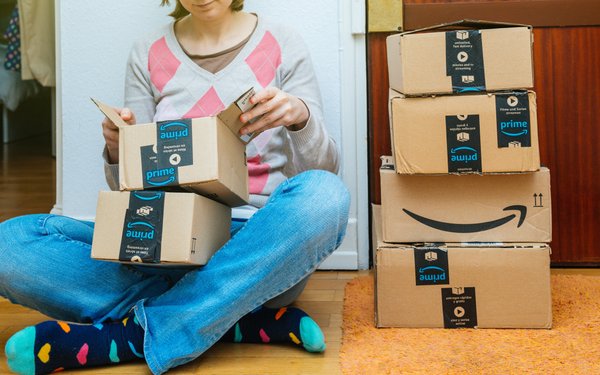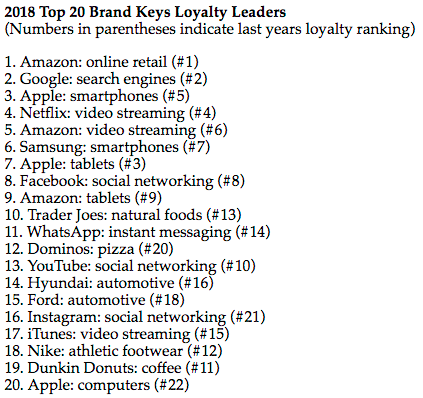
Digital brands continue to
garner the most brand loyalty, according to the 22nd annual Brand Keys 2018 Loyalty Leaders list.
Nine of the top 10 brands in the study are digital brands, with 35% digital tech, social
networking or digital facilitator brands.
The New York-based brand loyalty and customer engagement research consultancy examined 761 brands in 84 categories.
However, non-digital
brands did move up the Loyalty Leaders List an average of 11 positions, with a few making major leaps. That's an "incredible accomplishment" in today's marketplace where consumers are hot-wired to the
Internet, said Robert Passikoff, Brand Keys founder and president.
But traditional brands have worked harder to create the emotional value connections necessary to bolster the loyalty
necessary for keeping current customers, developing new ones, and making profits, according to the study.
advertisement
advertisement
“Lyft has managed to do it by providing down-to-earth friendly service, making
their service feel more like a ride from a friend than an Uber-basedn taxi service,” Passikoff tells Marketing Daily.
“Zara has done it by becoming the master of fast
fashion, and is managing to expand share of online loyalty by developing ship-from-store processes that reduce consumer ‘out-of-stock’ disappointment and increase brand engagement
levels.”
Loyalty is a predictive leading-indicator of future consumer behavior, according to Brand Keys. The more loyal the consumer, the better consumers behave toward a brand. The better
they behave, the better the brand does in the marketplace, Passikoff says.
He says he found the most interesting finding to be how fast traditional, non-digital/online brands are adapting
marketing and positioning to meet-consumer-expectations values, the same ones that made digital customers so very loyal.
“We’ve come to believe that traditional brands will
come in second to tech, so it’s been surprising to find that traditional brands are the ones showing the strongest growth when it came to loyalty this year,” Passikoff says.
The
five brands that showed the greatest loyalty leadership gains in 2018 were T.J. Maxx (+38 to #35, currently with net sales up 12%); 5 Guys Burgers & Fries (+36 to #64 and same-store sales up 3%)l
Zara (+32 to #57, with same-store sales +2%); Lyft (+18 to #77, now with 35% of the U.S. rideshare market); and JPMorgan Chase (+17 to #51 accompanied by an 18% increase in profits).
The five
brands with the greatest loyalty erosion were Airbnb (-68 to #99, suffering from regulatory and local-resident protests); Starbucks (-46 to #63, which announced the closing of 150 stores); MAC
Cosmetics (-42 to #81, caught up this year in an animal-testing controversy); Victoria's Secret (-33 to #93, with -6% same-store sales); and BuzzFeed (-21 to #86, with web traffic down and readers
heading back to traditional news sites.)
The future of loyalty will continue to lie in a brand’s ability to better meet customer expectations, more and more of which are based on
emotional values, Passikoff says.
“This is a portent of marketers' needs to better measure and leverage consumer emotions,” he says. “Oh, and that means something more
than being entertaining or working the social networking circuit, but the ability to make real emotional connections with the customer.”
The Brand Keys analysis was conducted in
September 2018 and includes assessments from 50,527 consumers, 16 to 65 years of age, recruited from the nine U.S. Census Regions.
Meanwhile, a Mintel study indicates that overall, the
majority of American consumers take pride in supporting products that are made in America, even as the economy becomes more global. In fact, 64% of U.S. consumers agree that buying "American- made"
products is important to them and 75% have a desire to support American businesses, up from 57% in 2013, according to “American Lifestyles: Markets In Motion -- U.S. -- April 2018.”
In 2017, consumer expenditure increased 4%, improving on the 3.3% growth rate seen in 2016. High growth was measured in leisure and entertainment (+6%), personal finance (+5%), and beauty and
personal care (+5%) categories.
